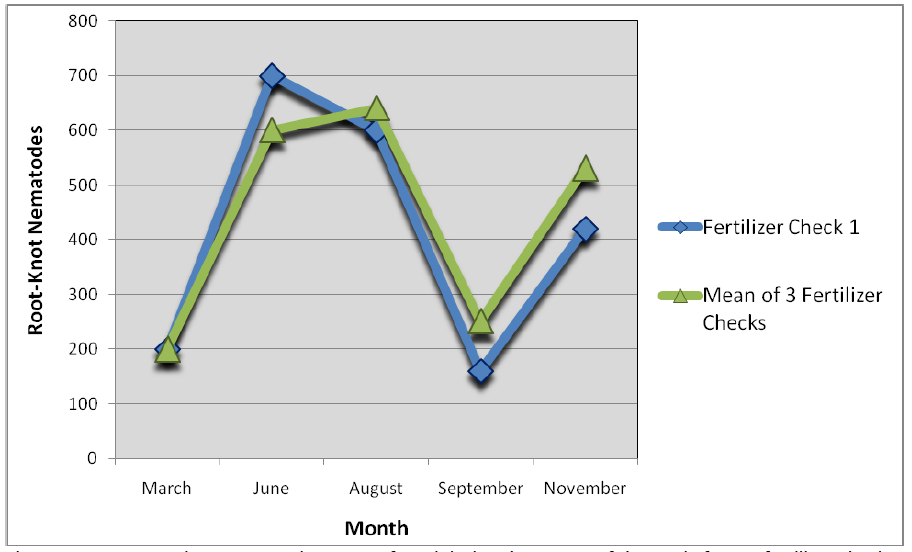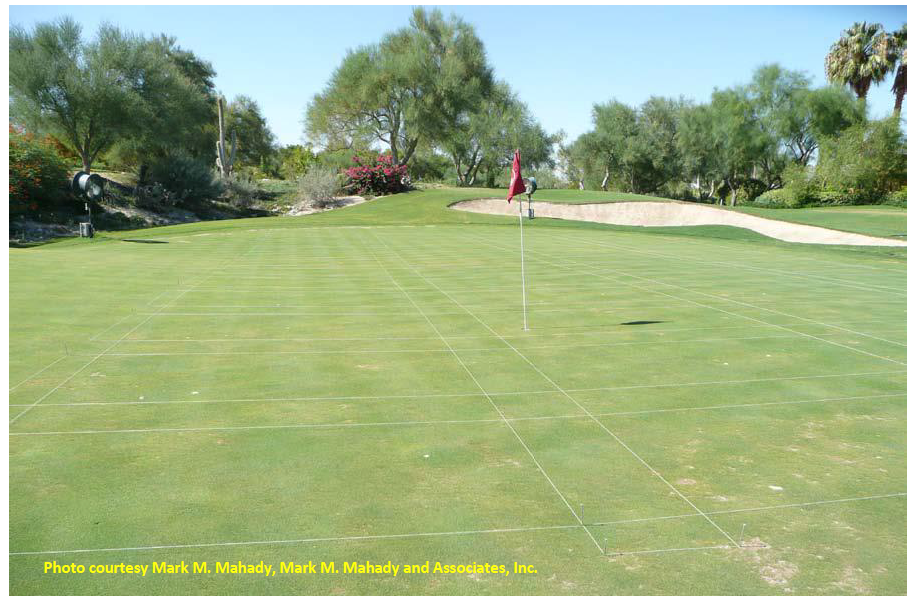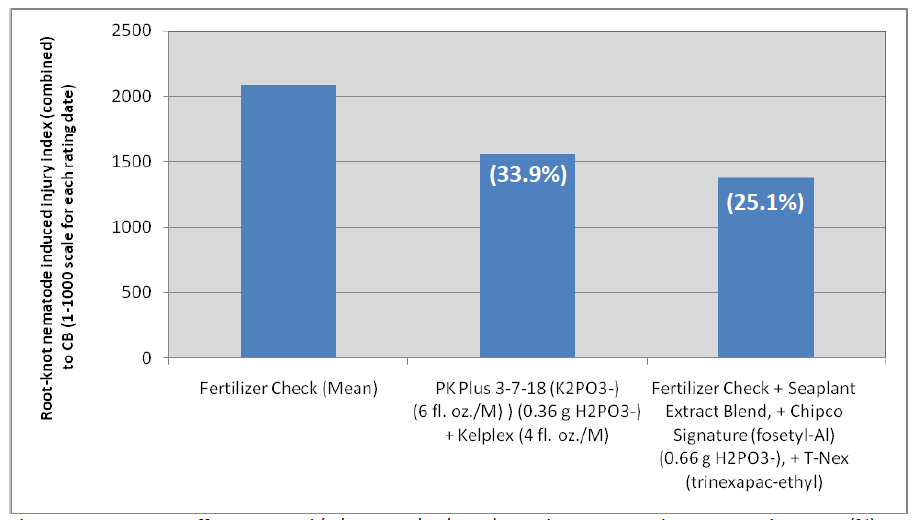Programs to Best Manage Root Knot Nematode
Research Topic: Evaluation of Programs to Best Manage Root Knot Nematode (Meloidogyne sp.) on a Creeping Bentgrass Putting Green (2010). M. M. Mahady, Mahady and Associates, Inc.
Abstract
Endoparasitic root-knot nematodes (Meloidogyne sp.) have become a major problem facing golf course superintendents, particularly in California. Plant parasitic nematodes attack turfgrass roots causing visible symptoms which include chlorosis, wilting, thinning, and death (Crow, 2005). Symptoms become more severe under increased biotic and/or abiotic stress. Crow (2005) provides an excellent review on nematodes and golf course turf. Given the limited number of nematicides currently unavailable for use, alternate management strategies that target plant health, or utilize biological controls, are being designed and tested with variable results. Phosphite (H2PO3-) was reported to disturb root-knot nematode induced giant cell development in wheat (Oka et al., 2007). In addition, bacteria of the genus Pasteuria, specifically P. usage, have been shown to reduce ectoparasitic sting nematode counts in the greenhouse, however not in the field (Luc and Crow, 2011). The objective of this trial was to evaluate products and programs to best manage (suppress) nematodes on a creeping bentgrass (CB) putting green. The research was conducted on the 13th hole of the Desert course at the Vintage Club at Indian Wells, CA. Ten (10) treatments were applied every fourteen (14) days from April 14, 2010 to November 10, 2010, including GRIGG P-K Plus (6 fl. oz./M) + Kelplex (4 fl. oz./M). Plots were 5’X10’ with four (4) replications. Response variables included turf color and quality, nematode damage (index), rooting depth/mass, and nematode counts. All samples were sent to the University of Arizona to determine nematode counts. Only root-knot nematodes were meaningfully impacted by the treatments, therefore this data is reported herein. Three (3) control treatments were implemented to account for site variability of nematode distribution. Nematode counts for the check plots are reported in Figure 1. The highest nematode pressure was observed in August, 2011 (Figure 2). Interestingly, the only two (2) treatments that reduced nematode pressure were those that contained phosphite and seaplant extract and included 1.) Fertilizer check + Seaplant Extract Blend, + Chipco Signature (fosetyl-Al) (0.66 g H2PO3-), + T-Nex (trinexapac-ethyl) and 2.) P-K Plus 3-7-18 (K2PO3-) (6 fl. oz./M) ) (0.36 g H2PO3-) + Kelplex (4 fl. oz./M). These treatments provided a 33.9% and 25.1% reduction in root-knot nematode counts respectively; however the reduction in nematode counts were not significantly different from the controls, yet represent a meaningful trend (Figure 3). Importantly, the P-K Plus 3-7-18 (K2PO3-) (6 fl. oz./M) (0.36 g H2PO3-) and Kelplex (4 fl. oz./M) treatment provided 86.1% reduction in CB injury on 30-Aug, which was the only treatment to provide significantly better reduction in CB injury compared each control treatment (Figure 4). For the entire study, this treatment produced the best CB quality under heavy nematode pressure. These results are interesting and signal the need for further research. Does the success or failure of chosen management strategy depend on whether the targeted nematode is endo or ectoparasitic? The combined treatment of P-K Plus® + Kelplex™ from GRIGG™ reduced endoparasitic root-knot nematode induced CB injury compared to all three fertilizers controls, including a statistical difference on one rating date (30-Aug). Practically speaking, if P-K Plus and Kelplex are used as part of a nematode management program, it’s important to apply them early and sequentially prior to the onset of environmental stress.

Figure 1. Mean root-knot nematodes counts found during the course of the study from a fertilizer check treatment (#1) and the mean of all three (3) fertilizer check treatments.

Figure 2. Field plot located on #13 green of the Desert Course at The Vintage Club on August 30, 2010. Note the turfgrass injury in the foreground.

Figure 3. Treatment effects on total (3/31 to 11/22/2010) root-knot nematode counts and percent (%) suppression.

Figure 4. Treatment effects on total (8/30 to 11/22/2010) root-knot nematode induced injury to creeping bentgrass (CB) and percent (%) suppression.
*Means followed by the same letter are not significantly different (P=0.05) using Student-Newman-Keuls and apply only to data taken from August 8/30/2010.
References
Crow, W.T. 2005. Plant parasitic nematodes on golf course turf. In: Nematodes on golf courses: Outlooks on Pest Management. February: p. 10-15. Online: http://entnemdept.ufl.edu/Crow_RP_07.pdf
Luc, J.E. and W.T. Crow. 2011. War of the worlds: bacteria vs. nematodes. In: Golf Course Management. March: p. 100-110.
Oka, Y., N. Tkachi and M. Mor. 2007. Phosphite Inhibits Development of the Nematodes Heterodera avenae and Meloidogyne marylandi in Cereals. Phytopathology. 97 (4): 396-404.
Chipco Signature is a registered trademark of Bayer Crop Science